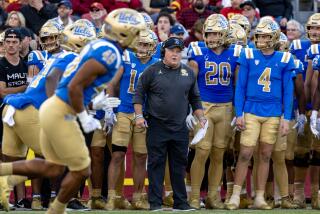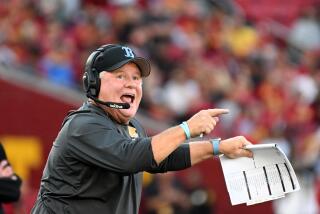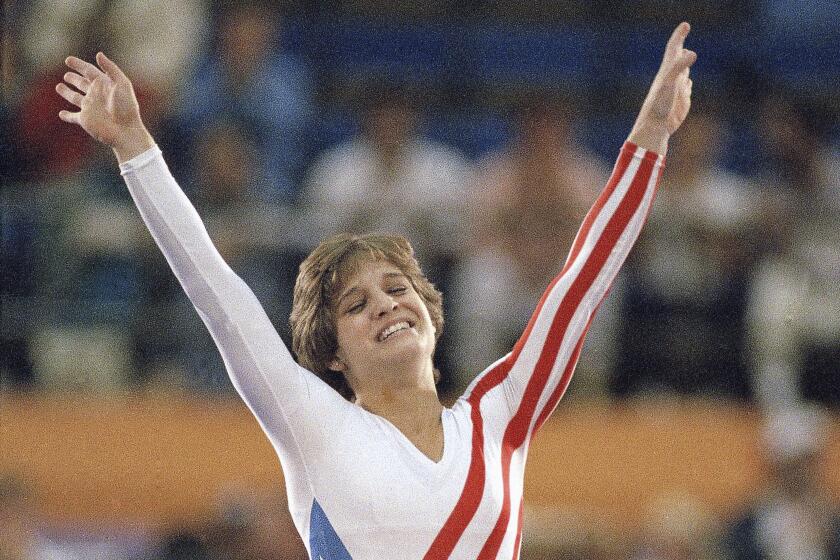Kelly Filled Big Shoes : Pro football: He had a Hall of Fame career after replacing the legendary Jim Brown in the Cleveland Browns’ backfield.
- Share via
When legendary running back Jim Brown stunned the Cleveland Browns in 1966 by retiring to pursue a movie career, he wrote a letter to head coach Blanton Collier.
“I told Blanton he wouldn’t miss me,” Brown said last week in a conversation from his home in Los Angeles. “I said that we had a great runner to replace me in Leroy Kelly, and that I had no doubt about his ability to become one of the NFL’s best backs.”
Brown’s words proved prophetic. In his first three seasons as Brown’s replacement, Kelly slashed his way for 3,585 yards, leading the league in rushing in 1967 and 1968.
He was also an excellent pass receiver and kick returner, finishing his NFL career with 12,329 combined yards and 90 touchdowns. On Saturday, Kelly -- an eighth-round draft pick out of Morgan State -- will be inducted into the Pro Football Hall of Fame in Canton, Ohio.
“Actually, I was surprised I got drafted at all,” said Kelly, 52, who grew up in Philadelphia and now lives in Willingboro, N.J. “I figured my best chance was to be picked by one of the American Football League teams. They held their draft before the NFL, and when I wasn’t selected, I figured I had even less chance of being chosen by the NFL.”
Browns Owner Art Modell credits the late Buddy Young, a former Baltimore Colts star, with bringing Kelly to the Browns’ attention.
“Back in the early ‘60s, scouting was hardly as sophisticated as it is today,” said Modell. “We scouted most of the big colleges, but schools like Morgan often got overlooked.
“Buddy was working for the NFL at the time, and he kept calling me to tell me about this kid named Kelly at Morgan. If it hadn’t been for that, we’d probably have missed out on one of the truly great running backs.”
Modell passed the scouting tip to his personnel director, Paul Bixler. By the time the eighth round began, Collier had excused himself and gone to sleep. The next morning, he asked Bixler about the team’s late-round draft choices.
“I got a halfback named Kelly in the eighth round,” Bixler said.
“Who the heck is Kelly of Morgan?” Collier said.
Kelly was hardly an overnight success at his first pro training camp. In fact, it took Brown’s intervention to keep him on the roster after the rookie sustained a severe hamstring pull.
“The strange thing was that this was the first time I had a pulled muscle,” Kelly said. “Because I was afraid I’d get cut if I missed practice, I kept playing and reinjuring it.
“But Jim Brown went to Coach Collier and our trainer, Leo Murphy, and said, ‘Give the kid a week off, and then he’ll show you what he can really do,’ and the coach took his suggestion.”
Kelly made a full recovery, and two weeks later, on a California exhibition swing against the Los Angeles Rams and San Francisco 49ers, he made several spectacular runbacks to win the job as the Browns’ kick returner.
“I could see he was a good runner,” Collier said. “He was fast, with good balance, but what struck me was his coverage on kicks. He was a vicious tackler. I knew we had a good player.”
Kelly’s teammates shared Collier’s opinion.
“We broke in together in 1964, and were roommates one year,” said Hall of Fame receiver Paul Warfield, now a sporting goods executive in Ohio.
“I was the No. 1 pick that year, but I’m sure I had the same kind of insecurities as Leroy about whether I was good enough to play in the NFL.
“The way things worked out, we both made big contributions as rookies to help the Browns win the championship that year (a 27-0 victory over the Colts).
“Leroy was so effective running back kicks, we usually started our drives near midfield. And with Jim Brown and the explosive offense we had, it was really difficult to stop us from scoring.”
Warfield credits Kelly with changing the strategy for kick returns.
“All the NFL teams generally formed a wall for the kick receiver, who would then make a break for the sidelines,” Warfield said. “And that’s the way the defense usually adjusted. But Leroy would take a lightning step to the left or right and break clear up the middle of the field. Coach Collier would say, ‘For us, it’s just like a draw play.’
“When Leroy became a starter in 1966, it made me that much more effective as a receiver. He was an excellent pass catcher, so the defense couldn’t concentrate on me. He froze a lot of linebackers.”
Kelly said he spent his first two years with the Browns in awe of Brown, perhaps the greatest running back of all time.
“I never tried to copy his style, but I learned so much just watching him run, especially the way he got out quick for a pitchout, snapped his head, made his move and was under total control after a few steps,” Kelly said.
“I had some big games running the ball after he retired, but my biggest thrill was starting a game in the backfield with Jim Brown my rookie year.
“(Fullback) Ernie Green got hurt, and I replaced him for a home game against Pittsburgh on a rainy Saturday night. I caught a couple of passes to keep our final drive alive, and we beat the Steelers in the last 20 seconds. Walking off the field that day with my arm around Jim Brown was something I’ll never forget.”
As a high school quarterback, Kelly won the Philadelphia public school scoring title his senior year to gain the attention of Morgan State, then a football power among the historically black colleges.
“I had some feelers from other schools, including Michigan, but my grades weren’t good enough,” Kelly recalled. “But Morgan and going to school in Baltimore seemed attractive to me. My sister, Dorothy, was living on Clifton Avenue at the time.”
The late Earl Banks, who became Morgan coach in 1960, had Pete Pompey at quarterback. So Banks converted Kelly to running back as a freshman.
“We played three years together,” said Pompey, “and Leroy was one of the most versatile football players I’ve ever seen.”
Pompey, who went on to play two years as a defensive back with the New York Jets and would become head basketball and football coach at Dunbar High, said: “The game I remember the best playing with Leroy was in my senior year against North Carolina A&T; in Greensboro.
“That was one of the toughest places to win on the road, plus it was their homecoming game. We got down 21-0 at the half, but in the second half, Leroy made two great catches and a great run off a fake punt and we won, 28-21.”
It was tough convincing the Browns of that. They signed Kelly for $10,000 plus a $7,500 bonus, which he used to help purchase a new home for his parents.
Cleveland released him in 1974. After an unsuccessful trial with the Oakland Raiders and playing briefly with the Chicago Fire in the World Football League, he retired.
On Saturday, he will be enshrined in the Hall of Fame. It would be only fitting for Kelly’s plaque to be placed alongside Jim Brown’s.
More to Read
Go beyond the scoreboard
Get the latest on L.A.'s teams in the daily Sports Report newsletter.
You may occasionally receive promotional content from the Los Angeles Times.










